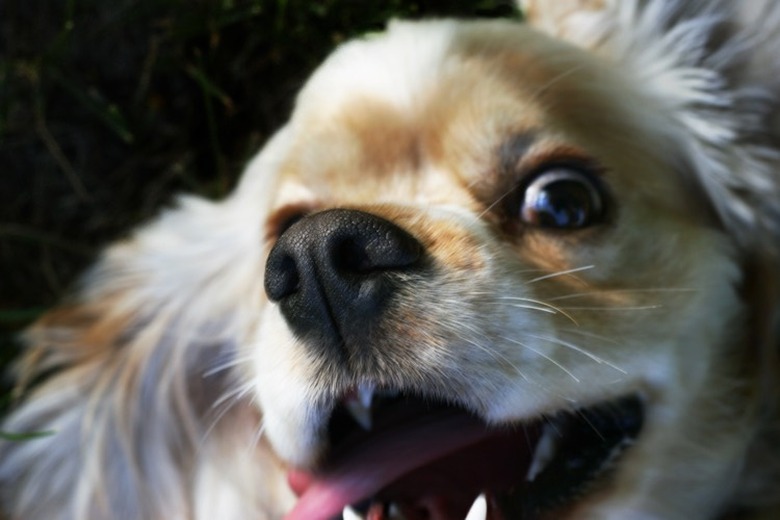Why Would A Dog Chew Another Dog's Whiskers?
Is Lucy missing some whiskers? Point the finger at her brother Carter. Dogs commonly chew another's whiskers during grooming sessions. This behavior has little to do with tidiness though. Canadian neuroscientists have suggested that this apparently affectionate "whisker chewing" might be in actuality an act of dominance.
NOTE: "Dominance Theory" is a widely debated topic among dog behaviorists, but we at Cuteness like to give voice to writers on both sides of the debate. For an opposing view, please see our article Social Hierarchy Among Dogs.
Vissibrae
Whiskers aren't just cute; they're extremely acute sense-receptors. The technical term is vissibrae and, acting as multidirectional antennae, they facilitate a dog's ability to comprehend the physical environment and attract potential mates. Vissibrae are so important, says canine expert Dr. Stanley Coren, that each one traces to specific points in the cerebral cortex.
Why Whiskers?
When it comes to objects at close range, Dr. Coren explains, dogs don't see well. Blame it on the placement of their eyes directly over those fuzzy snouts. Yet, this is where whiskers take over. They help dogs differentiate between items they prefer to eat, play with or else avoid. Dogs also use whiskers to navigate rooms without bumping into walls, detect movement, and assess air currents. Whiskers possess another remarkable feature: they aid the dispersal of pheromones, the hormone that attracts members of the opposite sex. Thus, these little appendages are essential for resource gathering and mating.
The Dalila Effect
Many other mammals, including mice, also possess vissibrae. Researchers at the University of Lethbridge in Canada, led by Dr. Justyna Sarna, observed groups of mice in a lab and theorized that the larger, more dominant mouse (male and female) usually performs the "whisker chewing" behavior, essentially nullifying would-be rivals. Though painful, servile mice often willingly accept it and even seek it out. The scientists termed this interaction the "Dalila effect," referring to the biblical character that cut Sampson's locks — the source of his physical prowess.
Of Mice and Dogs
If Dr. Sarna's "whisker chewing" conclusions are analogous to the same behavior in dogs, this would corroborate what many dog owners already suspect. By nibbling away another's whiskers, one of your dogs is asserting dominance over the other. Not that Carter should be punished, mind you. The need to establish a "pecking order" is instinctive. However, you might want to curb this. Willingly submitted to or not, the loss of such a valuable tool undoubtedly is disorienting and stressful for Lucy, not unlike the time Carter buried your wallet.
By Christopher Lapinel
References
NDI Behavioural Brain Research: The Dalila Effect; J.R. Sarna et al.
NCBI PubMed: The Role of Vibrissae in Behavior
Psychology Today: Why Dogs Have Whiskers
About the Author
Christopher Lapinel blogs for the Johnson Attorney's Group. He also writes his own blog at bluestonewriter.com. Lapinel holds an MLitt in creative writing from the University of St. Andrews and taught English composition at LaGuardia Community College.
